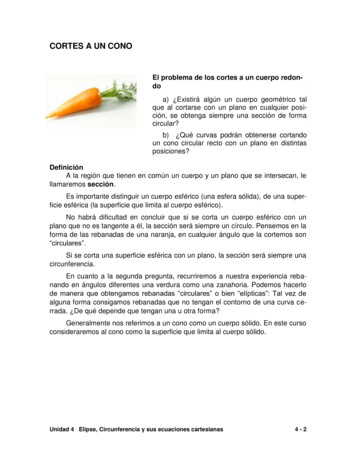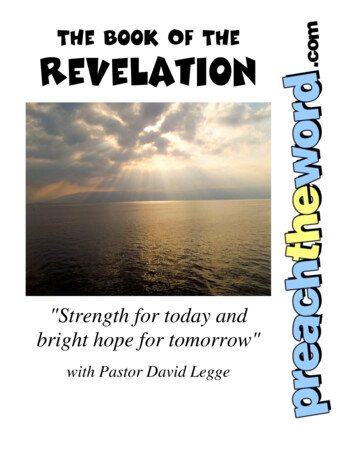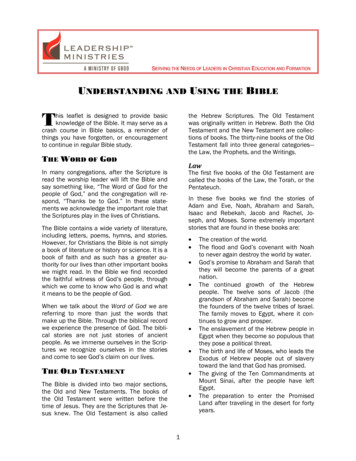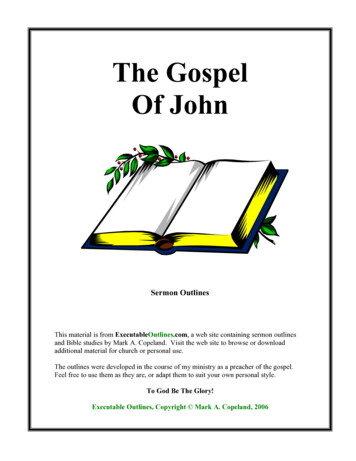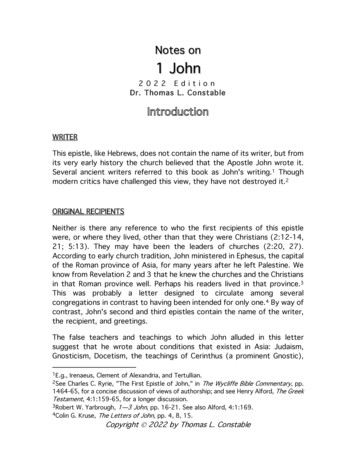
Transcription
Notes on1 John2 0 2 2 E d i t i o nDr. Thomas L. ConstableWRITERThis epistle, like Hebrews, does not contain the name of its writer, but fromits very early history the church believed that the Apostle John wrote it.Several ancient writers referred to this book as John's writing.1 Thoughmodern critics have challenged this view, they have not destroyed it.2ORIGINAL RECIPIENTSNeither is there any reference to who the first recipients of this epistlewere, or where they lived, other than that they were Christians (2:12-14,21; 5:13). They may have been the leaders of churches (2:20, 27).According to early church tradition, John ministered in Ephesus, the capitalof the Roman province of Asia, for many years after he left Palestine. Weknow from Revelation 2 and 3 that he knew the churches and the Christiansin that Roman province well. Perhaps his readers lived in that province.3This was probably a letter designed to circulate among severalcongregations in contrast to having been intended for only one.4 By way ofcontrast, John's second and third epistles contain the name of the writer,the recipient, and greetings.The false teachers and teachings to which John alluded in this lettersuggest that he wrote about conditions that existed in Asia: Judaism,Gnosticism, Docetism, the teachings of Cerinthus (a prominent Gnostic),1E.g.,Irenaeus, Clement of Alexandria, and Tertullian.Charles C. Ryrie, "The First Epistle of John," in The Wycliffe Bible Commentary, pp.1464-65, for a concise discussion of views of authorship; and see Henry Alford, The GreekTestament, 4:1:159-65, for a longer discussion.3Robert W. Yarbrough, 1—3 John, pp. 16-21. See also Alford, 4:1:169.4Colin G. Kruse, The Letters of John, pp. 4, 8, 15.2SeeCopyright Ó 2022 by Thomas L. Constable
Dr. Constable's Notes on 1 John22022 Editionand others. Explanations of these will follow in the exposition. Thesephilosophies extended beyond Asia, but they were present there duringJohn's lifetime."The heresy which occasioned 1 and 2 John cannot be parallelwith any other manifestation of heresy known from that era.Yet it has affinities with more than one such movement."1"The writer of 1 John was thus addressing a community, madeup of a number of house-churches in and around Ephesus ,which was split in three ways. It consisted of the following: (a)Johannine Christians who were committed to the apostolicgospel of Jesus as they had received it; (b) heretically inclinedmembers from a Jewish background; (c) heterodox followersfrom a Hellenistic (and/or pagan) background. The problemsrelating to the two 'heretical' groups, (b) and (c), wereprimarily theological and (by extension) ethical; althoughrelated difficulties concerning eschatology and pneumatologymay have been present also (see on 2:18 and 4:1 ). Tocomplete the picture, it should be noted that the life of theJohannine community was marked by the presence of a fourthgroup of people: the secessionists. Whereas the members ofthe first three groups could be found within John's circle, theanti-Christian secessionists had begun to break away from it.These were heretically inclined adherents of the Johanninecommunity. In some cases they may have been genuine, ifuninformed, believers. But in other instances they perhapsnever properly belonged to John's church (although theythought they did), because they never really belonged to God(see on 1 John 2:18-19; cf. also 2:22-23)."2DATEThis is one of the most difficult of all the New Testament books to date.One of the few references in the book that may help us date it is 2:19. IfJohn meant that the false teachers had departed from among the apostles,a date in the 60s seems possible. This could place it about A.D. 60-65,1RudolfSchnachenburg, The Johannine Epistles, p. 23.S. Smalley, 1, 2, 3 John, p. xxiv. Paragraph division omitted.2Stephen
2022 EditionDr. Constable's Notes on 1 John3before the Jewish revolts of A.D. 66-70 resulted in the scattering of theJews from Judea. In this case John may have written from Jerusalem.1However many conservative scholars believe that John wrote this epistlemuch later, between about A.D. 85 and 97, when he evidently wrote theGospel of John (ca. A.D. 85-95) and the Book of Revelation (ca. A.D. 9596).2 I prefer a date in the 90s, following the writing of John's Gospel,which 1 John seems to assume.3"Indeed the Epistle throughout has the Gospel as itsbackground and is hardly intelligible without it."4In view of the nature and the conclusion of the Book of Revelation, whichseems to be God's final revelatory word to humankind, I think John probablycomposed his epistles before that book. So a date for 1 John in the early90s, A.D. 90-95, seems most probable to me.5PLACE OF WRITINGSince John ministered in and around Ephesus later in his life, Ephesus seemsto be the most probable place from which he wrote this epistle.6CHARACTERISTICS"The Epistle is not a polemic [attack] primarily, but a letter forthe edification of the readers in the truth and the life in Christ.And yet the errors of the Gnostics are constantly before John'smind."71SeeZane C. Hodges, "1 John," in The Bible Knowledge Commentary: New Testament, p.882; idem, The First Epistle of John," in The Grace New Testament Commentary, 2:1192.2E.g., B. F. Westcott, The Epistles of St. John, pp. xxx-xxxii; F. F. Bruce, The Epistles ofJohn, p. 31; and Yarbrough, p. 17.3Cf. Smalley, pp. xxii, xxxii; Donald A. Carson and Douglas J. Moo, An Introduction to theNew Testament, pp. 676-77; and G. G. Findlay, Fellowship in the Life Eternal, p. 49.4David Smith, "The Epistles of St. John," in The Expositor's Greek Testament, 5:154.5See also Donald Guthrie, New Testament Introduction, 3:205-6.6See D. Edmond Hiebert, An Introduction to the New Testament, 3:191-97.7A. T. Robertson, Word Pictures in the New Testament, 6:200. Cf. Findlay, pp. 59, 69.
Dr. Constable's Notes on 1 John42022 Edition"John is contemplative rather than argumentative. He presentstruths as they come by intuitive perception rather than byreasoned conclusion. He is mystical rather than logical. He seesthe confirmation of truth in one's experience of it rather thanin demonstration by argument."1"John's pen is a surgeon's knife, not a philosopher's quill."2"St. John has no liking for progress along an unending straightroad; he loves a circling flight, like his symbol, the eagle."3" we should read 1 John, not trying to discern the flow ofthe argument as we would in a Pauline letter, but ratherrecognizing that it is, in its structure and rhetorical form [aform that is intended to persuade or impress], a piece ofepideictic rhetoric [characterized by a display of speaking orwriting skill]."4OUTLINEJohn's style of writing makes it difficult to outline this book. He flows fromone subject to another so smoothly that it is often difficult to see clearbreaks in his thought. In contrast, Paul typically identified changes in hissubject matter clearly. Consequently, in the outline below some divisionsoccur at unusual places in the text: not necessarily chapter divisions oreven verse divisions. The following outline reflects the structure of a typicaldeliberative oration that was common in John's world.5I.II.Introduction: the purpose of the epistle 1:1-4Living in the light of fellowship with God 1:5—2:11A.B.1J.Staying on the path by walking in God's light 1:5—2:2Reaching the goal by knowing the God of light 2:3-11Sidlow Baxter, Explore the Book, 6:321.6:324.3Adolf Deissmann, Light from the Ancient East, p. 401.4Kruse, p. 31.5See Zane C. Hodges, The Epistles of John, pp. 31-33, who followed George A. Kennedy,New Testament Interpretation through Rhetorical Criticism.2Ibid.,
2022 EditionIII.Appreciating spiritual advances 2:12-14Recognizing spiritual adversaries 2:15-271.2.Abiding to face Christ confidently 2:28Learning to recognize God's children 2:29—3:10aLearning to recognize Christian love 3:10b-231.2.3.D.E.What love is not 3:10b-15What love is 3:16-18What love does for believers 3:19-23Learning to recognize the God of love 3:24—4:161.2.3.God's indwelling affirmed 3:24God's Spirit recognized 4:1-6God's indwelling recognized 4:7-16Having boldness at Christ's judgment seat 4:17-19Learning how to live obediently 4:20—5:17A.B.C.VI.Overcoming the world 2:15-17Resisting the antichrists 2:18-27Living in anticipation of Christ's judgment seat 2:28—4:19A.B.C.V.5Resisting enemies 2:12-27A.B.IV.Dr. Constable's Notes on 1 JohnThe meaning of brotherly love 4:20—5:3aThe empowerment of brotherly love 5:3b-15The consequences of brotherly love 5:16-17Christian certainties 5:18-21Ron Bigalke saw the structure of 1 John as being chiastic:11Achiasmus is a rhetorical or literary figure in which words, grammatical constructions, orconcepts are repeated in reverse order, in the same or a modified form.
Dr. Constable's Notes on 1 John6"A2022 EditionPrologue: Eternal Life (1:1-4)BThree Witnesses (1:5—2:2) (to deny sin is to make God aliar) (walk)CThe love of God and the believer (2:3-17)DFalse christs (2:18-27)Believer's confidence (2:28—3:10) (do not sin)EFE'D'C'B'A'Love proves abiding (3:11-18)Believer's confidence (3:19-24) (do keep God'scommands)False prophets (4:1-6)The love of God and the believer (4:7-21)Three Witnesses (5:1-12) (to deny Jesus is to make God aliar) (testimony)Epilogue: Eternal life (5:13-21)"1MESSAGEIf I were to boil down the message of this epistle into one sentence it wouldbe this: Fellowship with God is the essence of eternal life. Paul wrote inPhilippians 3:7-14 that his relationship with God was the most importantthing in his life—by far. John wrote this epistle in order to enable believersto appreciate their fellowship with God, and he wrote to deepen thatfellowship."It would not be inappropriate to write over this epistle as awhole, THE GATEWAY TO FELLOWSHIP WITH GOD."21RonJ. Bigalke, "Identity of the First Epistle of John: Context, Style, and Structure,"Journal of Dispensational Theology 17:50 (Spring 2013):43.2Baxter,6:329.
2022 EditionDr. Constable's Notes on 1 John7Both the Gospel of John and the First Epistle of John deal with the subjectof eternal life.1 John wrote his Gospel so that his readers might "believethat Jesus is the Christ, the Son of God, and that by believing you mayhave life in His name" (John 20:31).2 John wrote this epistle to Christiansso that they could have fellowship with the apostles, with God the Father,and with Jesus Christ (1 John 1:3). He wrote it so that we might experiencethe fullness of the eternal life that we possess (cf. John 10:10). However,the subject of this epistle is not eternal life but fellowship with God.Fellowship with God is the essence of eternal life (cf. John 17:3).This epistle grew out of Jesus' Upper Room Discourse (John 14—17).Similarly, James' epistle grew out of Jesus' Sermon on the Mount (Matt.5—7), Peter's first epistle grew out of Jesus' Discipleship Discourse (Matt.10), and the Book of Revelation grew out of the Olivet Discourse (Matt.24—25). In the Upper Room Discourse Jesus explained what the apostles'relationship to God would be after He sent the Holy Spirit to indwell them(John 14:16-17). John expounded that revelation in this letter.There are several terms in this epistle that John used as synonyms:fellowship with God, knowing God, abiding in God, and seeing God. Theseterms all describe the experience of Christians. They all describe ourrelationship with God in varying degrees of intimacy.Our relationships with people vary. Some are more intimate, and some areles intimate. Fellowship with God is also a matter of greater or lesserintimacy. When we speak of being in fellowship or out of fellowship, we areoversimplifying our relationship to God. For example, a child's fellowshipwith his or her parents is rarely either perfect or non-existent. It is usuallysomewhere between these extremes, and it may vary from day to day.John's purpose in writing was to motivate his readers to cultivate greaterintimacy with God. The greater the intimacy, the greater our fellowship, thebetter we know God experientially, and the closer we abide in Him (cf. John14:21-24). The greater our intimacy with God, the more we will experiencethe life that is eternal. All Christians possess eternal life, but not all1Seethe tables of corresponding expressions in John's Gospel and his First Epistle in B. F.Westcott, The Gospel According to St. John: The Authorised [sic] Version withIntroduction and Notes, pp. lxi-lxiii.2Quotations from the English Bible in these notes are from the New American StandardBible (NASB), 2020 edition, unless otherwise indicated.
8Dr. Constable's Notes on 1 John2022 EditionChristians experience that life as God intended us to enjoy it (John 10:10).Similarly, all living human beings have life, but not all live an abundant life.This letter reveals two things about the life of fellowship: First, it revealsthe resources of this life. There are two resources:The first resource is objective. God has provided a pattern for the life offellowship, and that pattern is Jesus Christ. In Christ we have personifiedtwo qualities that are characteristics of God that should also characterizeus as the children of God:The first of these qualities is light. Jesus Christ constantly walked in thelight of God's holiness (1:5-6; 2:6). He never hid from God. He alsoconformed to the light of God's will perfectly. He was submissive, sinless,pure, and consecrated. The second of these qualities is love. Jesus alsoconstantly manifested the love of God (cf. 4:10). In His attitudes andactivities Jesus always demonstrated perfect love. His words and His deedswere a revelation of God's love. Jesus put others before Himself. He wasselfless as well as holy.The second resource of the life of fellowship is, according to this epistle,subjective. God has not only provided a pattern for the life of fellowship,He has also provided the power for it. Jesus Christ is not only an externalexample for us to imitate. But even more helpfully He is an internal powerwhom God has placed within us, who is at work in our lives. With eternal lifewe get Jesus (5:11-12). And with Him come two things:First, we get light. We see spiritual things that we never saw before (2:20).We see how we ought to walk (2:27). We become sensitive to sin. Second,we get love. We see the need of other people who are groping in darkness,and we desire to reach out to them in service, and to bring them into thelight (4:7). As soon as we share God's life, we begin to love with God'slove. We can quench love, but every person who has eternal life has lovewithin him or her.To review, this letter reveals two things about the life of fellowship: firstthe resources of this life, which are an external pattern and internal power.Both of these come from Jesus Christ.This letter also reveals the results of a life of intimate fellowship with God.These are two also:
2022 EditionDr. Constable's Notes on 1 John9First, there is value for the Christian. This value is that we realize life asGod intended people to live it. We can experience life as God meant it tobe when He first made people. We achieve our potential as human beingsto the degree to which we walk in fellowship with God (i.e., abide in Him).Our intimacy with God perfects our personalities.Second, there is also value for God. God enjoys fellowship with people.God's purpose in creation and redemption was to have fellowship withpeople. God finds in every person who walks with Him in intimate fellowshipa person through whom He can manifest Himself, an instrument throughwhom He can accomplish His purposes. The abiding believer reveals God tothose around him or her. God does not have to work on abiding believerswith chastening, but He can work through them in blessing others andthemselves.John also called on his readers to fulfill their responsibilities in the life offellowship. Regarding the light, we have two responsibilities:First, we must obey the light (1:7). That means responding positively tothe knowledge of God's will that we gain. We can become calloused to thetruth. This is a special danger when one spends a lot of time dealing withspiritual matters. Believers need to cultivate their relationship with Goddaily. We all need to keep weeding the gardens of our spiritual lives.Second, we must seek the light (1:9). We need to forsake the darkness ofsin and keep walking in the light. The circle of God's light may move. Wemay gain new understanding of His will. When that happens, we need tomove into that light in obedience (cf. Ps. 119:105).Regarding love, we also have two responsibilities:First, we must yield to its impulse. We can destroy our capacity to love bynot expressing love when God moves us to do so. We can lose our passionfor the lost by resisting the Holy Spirit's promptings to reach out in love.We need to be ready to sacrifice rather than to put ourselves first.However, if we yield to the impulse of love, to serve others, our love willdeepen and intensify. We must not quench the Spirit if He is prompting usto reach out to someone with love.Second, we must also guard love's purity. We need to watch out for falsecharity. True love never sacrifices principle. God never loved at the expenseof light. Love never justifies sin.
10Dr. Constable's Notes on 1 John2022 EditionIn conclusion, I would like to suggest two applications of the message ofthis epistle, one to the individual and one to the church.First, let me make one application to us as individual Christians. We caneasily test whether we are living in close fellowship with God. Check thelight and the love that is in your life. Is the light of holiness shining clearly,or are you walking in darkness? Is your love still burning brightly, or hasyour life deteriorated to the level of only learning God's Word? Learning isonly one means to the end of living—living in intimate fellowship with God.What do you want people to remember you for, your knowledge or yourlove? In view of 1 Corinthians 13, I want to be remembered for my lovemore than for my knowledge.Second, let me make one application to us as the church of Jesus Christ.We need to keep our priorities in line with God's. Intimacy is His goal for us.God prefers a few committed disciples to a multitude of compromisingdisciples (cf. Jesus' 12 disciples). A pure church is more important to Himthan a large church. Pastors should not draw back from urging people towalk in the light, and to walk in love, just to increase the size of theircongregation. They need to make as broad an appeal as possible withoutpulling their punches in ministry. I am referring here to the church's ministryof equipping the saints. In presenting the gospel, we should make as broadan appeal as possible.11Adapted93.from G. Campbell Morgan, Living Messages of the Books of the Bible, 2:2:177-
2022 EditionI.Dr. Constable's Notes on 1 John11INTRODUCTION: THE PURPOSE OF THE EPISTLE 1:1-4"This writing begins without any of the formal featurescharacteristic of a letter, such as we found in 2 John and 3John. Since the conclusion also lacks any typical features of aletter, we must conclude that the writing is not so much aletter as a written sermon or address."1John began this epistle by explaining to his audience why he wrote. He saidthat he wrote so that his readers would enjoy the fellowship with God thatbefore this was possible only to those who had seen Him. This fellowship,he explained, rests on the reality of Jesus Christ's incarnation, and it resultsin full joy for those who experience it."No writer in the New Testament holds with greater intensitythe full reality of the incarnation."21:1The beginning (Gr. arche) may refer to the beginning of allthings (2:13-14; John 1:1), or the beginning of the creation(3:8; Gen. 1:1), or to Jesus' incarnation (v. 2; cf. John 1:14).It could also refer to the beginning of Jesus' earthly ministry(Acts 1:22-24), the beginning of the Christian gospel (Mark1:1-4), or the beginning of the readers' experience asChristians (2:7, 24; 3:11). The beginning of Jesus' earthlyministry, specifically the beginning of His teaching ministry,seems most consistent with what John proceeded to sayabout that beginning (cf. vv. 1b, 3a)." he [John] proclaims a message that has beenembodied in a person—the person of JesusChrist."3"The phrase 'from the beginning,' frequently usedin 1 John [2:7, 13, 14, 24 (twice); 3:8, 11; cf. 2John 5, 6], refers for the most part to the1I.Howard Marshall, The Epistles of John, p. 99. Cf. Carson and Moo, p. 669.Barclay, The Letters of John and Jude, p. 17.3Kruse, p. 53.2William
Dr. Constable's Notes on 1 John122022 Editiondoctrine proclaimed at the beginning (2:7, 24;3:11) and is intended to move the readers toremain faithful to that doctrine as against theteachers of heresy who appeared only later."1"The source of spiritual life to men is that whichwas, in the first instance, the source of natural lifeto all creatures. Here lies the foundation-stone ofthe Johannine theology. It assumes the solidarityof being, the unity of the seen and unseen. It rulesout from the beginning all dualistic and Doketicconceptions of the world."2John was probably referring to all that the apostles hadexperienced with Jesus from the time that they first becameHis disciples. John's verbs (have heard, have seen, have lookedat, and touched) indicate a progressively closer approach tothe object of investigation. The essence of fellowship isincreasing intimacy. Our fellowship with God must involvedrawing closer to Him and viewing Him more intently all thetime in order for it to be genuine fellowship. The same is trueof fellowship on the human level."To look, saves; to gaze, sanctifies."3John used three of his basic senses (hearing, eyesight, andfeeling) to highlight the reality of the object so that his readerswould know that he was not speaking metaphorically. He citedpersonal experience and appealed to verifiable evidence tosupport the humanity of Jesus Christ (cf. Luke 24:39). Somefalse teachers denied His humanity.4"Extreme Docetism [i.e., Docetic Gnostics] heldthat Jesus was not human at all but was merely aprolonged theophany, while moderate Docetism[i.e., Cerinthian Gnostics] considered Jesus the1Schnachenburg,p. 57.p. 86. Docetist believed that some things only seemed to be real.3J. Vernon McGee, "The First Epistle of John," in Thru the Bible with J. Vernon McGee,5:757.4Bruce, pp. 16-17.2Findlay,
2022 EditionDr. Constable's Notes on 1 John13natural son of Joseph and Mary, upon whom Christcame at the time of baptism."1Specific instances of personal encounter with Jesus Christ (cf.Luke 24:39) had left a continuing impression on John, as isclear from the verb tenses (perfect in the Greek text).John may have used "we" editorially to represent himselfpersonally, or "we" may include all Christians. It is more likely,however, that "we" represents John and the othereyewitnesses of Jesus Christ: Jesus' apostles.2 In this epistleJohn was speaking for others besides himself, and he wasseeking to persuade still other believers of something not allof them had experienced or acknowledged (cf. Luke 1:2).3The word of life probably refers to the message about JesusChrist, namely, the gospel.4 John referred to Jesus as the Wordin his Gospel, and he described Jesus claiming to be the life(John 14:6). The phrase word of life seems more likely todescribe the message about the Person who is and whopersonifies life (cf. v. 2; Phil. 2:16; Acts 5:20). John probablyspoke of Christ as "what," rather than "He" because here hewanted to emphasize the content of the message about Christrather than the person of Christ.1:2Life is a title of Jesus Christ here, like Word is in John's Gospel(John 1:1). "Life" reflects the Christian experiences aboutwhich John wrote here, whereas the "Word" (Gr. logos)reflects the facts that Jesus declared and that John recordedin the fourth Gospel. Grace and truth explain the Word in John'sGospel (John 1:14), but light and love clarify the Life in hisepistles.In verse 1 the progression in the series of verbs (heard, seen,looked at, and touched) reflects increasingly intent attention1Ryrie,p. 1464. Cf. Robertson, 6:200.p. 70.3D. Edmond Hiebert, "An Expositional Study of 1 John," Bibliotheca Sacra 145:578 (AprilJune 1988):203.4Westcott, The Epistles , pp. 6-7; C. H. Dodd, The Johanine Epistles, pp. 3-6; J. L.Houlden, A Commentary on the Johanine Epistles, pp. 50- 52; Findlay, p. 83.2Findlay,
14Dr. Constable's Notes on 1 John2022 Editionto Jesus as the essence of fellowship. The progression in theverbs in verse 2 (revealed, seen, testify, and proclaim) showsthe result of contemplating Jesus Christ and enjoying Hisfellowship, namely, bearing witness. One first sees themanifested Christ. Then, having seen, he or she is able to bearwitness. Finally, one feels impelled by what he or she has seento announce to others the message of life.There is a strong stress on the eternality of the Life (JesusChrist) in this verse. The emphases on the quality of the life(eternal) and its equality with the Father make this point (cf.John 1:2). The Incarnation is in view.Eternal life is such a dominant theme in this epistle that onewriter even entitled his commentary on 1 John: The Epistle ofEternal Life.1 In John's writings eternal life is also synonymouswith salvation.21:3"You," the recipients of this epistle, must have been genuinebelievers in view of how John referred to them (cf. 2:12-14,21, 27; 5:13). They had not known Jesus Christ in the flesh asthe apostles had. John wrote to them so they could enter intoand continue to enjoy the intimate fellowship with Christ thatthe apostolic eyewitnesses enjoyed (cf. Acts 10:40-41).3"This verse introduces the purpose of the Epistle:'that you also may have fellowship with us. Andour fellowship is with the Father and with his Son,Jesus Christ.'"4"The main theme of the Epistle is fellowship withGod."51G.Goodman.p. 10.3Westcott, The Epistles , p. 4.4Glenn W. Barker, "1 John," in Hebrews-Revelation, vol. 12 of The Expositor's BibleCommentary, p. 307.5John G. Mitchell, Fellowship, p. 14. Cf. Robert Jamieson, A. R. Fausset, and David Brown,Commentary Practical and Explanatory on the Whole Bible, p. 1495; G. Campbell Morgan,The Unfolding Message of the Bible, p. 363-64; idem, An Exposition of the Whole Bible, p.527; Kenneth S. Wuest, Word Studies in the Greek New Testament, 4:1:59-60; Hodges,2Smalley,
2022 EditionDr. Constable's Notes on 1 John15"As a basis for comparison it is important torecognize that 1 John can express its favoriteideas in various ways. Alongside of 'to havefellowship with God,' which sounds general enoughand is only found in 1:3 and 6, one of thecommonest phrases is 'to be in God' (2:5; 5:20)or 'to abide' (2:6, 24; 3:24; 4:13, 15, 16). Another expression for fellowship with God foundonly in John is 'to have God (or the Son)' (1 John2:23; 5:12; 2 John 9). Finally, 'to know God'comes to the same thing. It occurs in the perfecttense in 2:3 (cf. 2:5); 2:13, 14 (cf. 1:3) with thesame meaning."1"Here we are given, without any hesitation, adescription, the summum bonum [greatest good],of the Christian life; here, indeed, is the wholeobject, the ultimate, the goal of all Christianexperience and all Christian endeavour. This,beyond any question, is the central message ofthe Christian gospel and of the Christian faith."2Fellowship requires and rests on information, a common bodyof knowledge, and mutual acceptance of that data. John wroteto share this information with his readers."Thus two fundamental truths, which thephilosophical heresies of the age were apt toobscure or deny, are here clearly laid down at theoutset: (1) the distinctness of personality andequality of dignity between the Father and theSon; (2) the identity of the eternal Son of Godwith the historical person Jesus Christ."3The Epistles , pp. 34, 50; idem, "The First ," 2:1192, 1194; Ryrie, p. 1466;Schnachenburg, pp. 63-64; Kenneth G. Hanna, From Gospel to Glory, p. 451; Eugene Pond,"1 John," in Surveying Hebrews through Revelation, p. 88.1Schnachenburg,pp. 63-64.Martyn Lloyd-Jones, Fellowship With God: Studies in 1 John, p. 77. Cf. Findlay, p. 134.3Alfred Plummer, The Epistles of S. John, p. 20.2D.
16Dr. Constable's Notes on 1 John2022 Edition"It is an interpretive mistake of considerablemoment to treat the term 'fellowship' as thoughit meant little more than 'to be a Christian.'"1False teachers were preaching information about Jesus Christthat was not true. John also wrote to combat their deception(2:26)." the epistle is written to a believingcommunity that is dealing with fallout from thedeparture (2:19) of persons with beliefs andpractices the author cannot endorse."2"Only when we think aright of Jesus Christ, are wein unison with God. Only when we think aright ofHim and are rightly disposed toward Him, can wehave fellowship with each other; only on thiscondition can we work together with God for theworld's redemption "31:4Here "we" is probably editorial. "These things" refers to whatJohn wrote in this epistle. Not only would his readersexperience full (complete) joy, but so would John, as thereaders entered into and continued in intimate fellowship withGod (cf. 3 John 4). Joy is the product of fellowship with God.When there is no joy, there is no fellowship (cf. John 15:11;16:24).In summary, John wrote as an apostolic eyewitness of Jesus Christ and Hisearthly ministry. He identified two dangers to readers that are stillprevalent in the church today: One is the assumption that Christianfellowship is possible without common belief in Christ. The other is theassumption that someone can have a relationship with God without arelationship with Jesus Christ.4 John wrote this epistle so his readers mightjoin and continue in the fellowship with God that is possible only for those1Hodges,"1 John," p. 883. See 3:24.p. 29.3Findlay, p. 91.4Marshall, p. 107-8.2Yarbrough,
202
1 "John's pen is a surgeon's knife, not a philosopher's quill."2 "St. John has no liking for progress along an unending straight road; he loves a circling flight, like his symbol, the eagle."3 " we should read 1 John, not trying to discern the flow of the argument as we would in a Pauline letter, but rather
